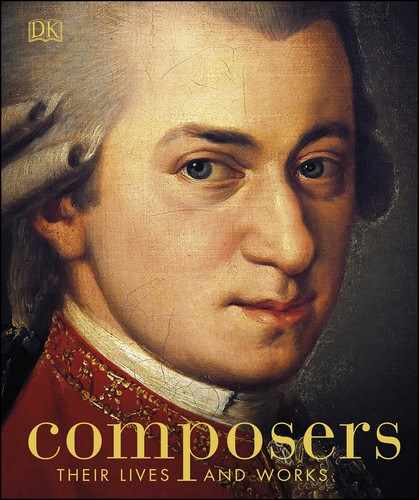William Walton
1902–1983, BRITISH
From humble beginnings, Walton rose to fame as the darling of London’s musical society between the two world wars, living the life of a playboy before settling into semi-retirement on the Italian island of Ischia.

WILLIAM WALTON
The English composer burst into the limelight in 1923 with his controversial work Façade. He went on to become a key figure in mid-20th-century British music and was knighted in 1951.
IN PROFILE
The Sitwells
From about 1915 to 1930, the three siblings of the aristocratic Sitwell family, Edith, Osbert, and Sacheverell, became known in London “society” as the center of a circle of upper-class, fashionable young people with literary and artistic pretensions. Each of the Sitwells achieved modest success and a brief period in the limelight: Edith as a poet (see main text), Osbert as a writer and art critic, and Sacheverell as a music and art historian. However, unlike the contemporary and greatly revered Bloomsbury Group (to which they are sometimes compared), the Sitwells’ fame was largely built on notoriety and eccentricity rather than on artistic merit.

PORTRAIT OF EDITH SITWELL, ROGER FRY, 1915
William Walton was born in Oldham, Lancashire, in 1902. Although not well off, his family was musical and soon recognized William’s talents in this field. In 1912, he was accepted into Christ Church Cathedral School in Oxford, where he spent the next six years. It was at this choral school that he began composing.
His abilities gained him a place, aged only 16, as an undergraduate at Christ Church, a college of the University of Oxford. Although he excelled there at music, he neglected other academic subjects, repeatedly failed exams, and left the university without a degree in 1920. However, at Oxford he had become close friends with poets such as Siegfried Sassoon and Sacheverell Sitwell. The latter invited him to lodge in London with his siblings, Edith and Osbert. The Sitwells (see box) provided Walton with an attic in Chelsea where he could work, as well as an introduction to London society and its writers, artists, and composers.

FACADE, SUITE NO. 1, 1926
This is the front cover for Suite No. 1 of Walton's Façade, composed for Edith Sitwell's eccentric verses. The work brought him fame and popularity.
A different kind of music
Walton’s work at this time, including an early string quartet, was in an avant-garde, experimental style. But in 1923 he created Façade, a new kind of music—surreal verses by poet Edith Sitwell (recited by her at the premiere through a megaphone), accompanied by Walton’s jazzy and tongue-in-cheek music for small ensemble. It captured the 1920s zeitgeist, and although many were outraged, Walton had made his mark.
Trading on his reputation, he went on to write more serious orchestral works, including the massive cantata Belshazzar’s Feast (1931), his First Symphony (1935), and concertos for viola and violin. Having drifted away from the Sitwells, whose influence was on the wane, he embarked on a series of affairs, the most lasting of which was with Alice, Viscountess Wimborne, which began in 1934. He was exempted from military service during World War II so that he could provide music for propaganda films such as The First of the Few, and Laurence Olivier’s Henry V, while living on Alice’s estate in Northamptonshire.
Final movements
After the war, Walton found it difficult to return to composition, particularly after Alice died in 1948. But later that year, at a conference in Buenos Aires, he met, and soon married, Susana Gil Passo, an Argentinian woman.
By now, the composer's music was no longer fashionable, and although he was regarded highly enough to be commissioned to write the coronation march Orb and Sceptre for Elizabeth II, his output decreased significantly, especially after an operation for lung cancer in 1966. He and Susana moved permanently to the Mediterranean island of Ischia in 1956, where he died on their estate, La Mortella, in 1983.

THE GARDENS OF LA MORTELLA
These magnificent gardens were created by Susana Walton, wife of William, at their estate on the island of Ischia, where they moved to in 1956. The gardens were opened to the public in 1991.
